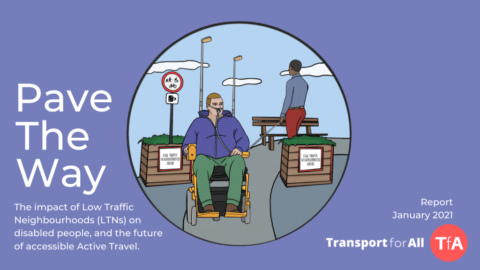Rainbow crossings and beyond, street design makes LGBTQIA+ people feel safer

By Graham Read, Design Manager, and Progress Pride Network co-lead, Sustrans
As LGBTQIA+ people, we hide aspects of ourselves, code-switching, behaving, dressing and even walking differently to blend in and not become a target for abuse.
We’re often hyper-aware of ourselves, our environment and those around us.
I’ve heard it referred to as constantly risk assessing. It’s the same for women, disabled people, refugees and Black, Asian and other people from minoritised ethnicities, and those at these groups’ intersections.
Checking who could be a threat.
Checking who may help if we are attacked or harassed.
Checking for escape routes, and if walking or wheeling (using a wheelchair or other mobility aid), only taking open, well-lit ways, even if they take longer.
Attitudes are changing, but every attack, every hate crime, every incident of abuse is one too many.
I asked LGBTQIA+ Sustrans colleagues what helps them feel safe. One said: “I need to know an area. Shockingly, I still feel too self-conscious and expect negative attention otherwise. But if an area I don’t know has some Progress Pride flags about then I feel more at ease.”
Another said because of past homophobic abuse they don’t feel safe walking past pubs with groups of men, particularly older men, smoking outside, but if there were women it wasn’t so bad.
I’ve had slurs shouted at me on the street and even a drink thrown from a passing car.
I am a white cisgender man, and my experience is a drop in the ocean compared to what others, especially people of colour, women and trans people, regularly experience.
Hate crimes and harassment
For too many LGBTQIA+ people harassment is a commonplace experience.
With multiple protected characteristics, for example a Black lesbian woman, there can be intersectional layers of discrimination such as racism, homophobia and misogny.
Studies show that women experience disproportionate levels of harassment in public spaces compared to men.
And UK government data shows from 2018-2020 there was a big increase in hate crimes, 19% for sexual orientation, 16% for transgender, and 9% for disability.
A staggering 53% of trans people aged 18-24 and 41% of trans people of all ages have experienced a hate crime incident in the past year.
This is deeply alarming — the UK trans population is estimated to be between 200,000 and 500,000.
For the Sustrans Walking and Cycling Index, published in May, we surveyed more than 24,000 people in urban areas in the UK and the Republic of Ireland.
Only 51% of those surveyed identifying their gender ‘in another way’ and 59% of LGBQ+ people feel welcome on the streets where they live, compared to 65% of women, 67% of men and 67% of heterosexual people.
Safer public space design
Safety on our streets can often be associated with increased police presence, but 79% of trans people do not report hate crimes because they don’t feel supported or experience further discrimination.
So, safety must be designed into our surroundings – public spaces have traditionally been designed for and by white heteronormative men, and they can work well for those individuals, but less so for everyone else.
The Queering Public Space report by Arup and the University of Westminster recommends incorporating LGBTQIA+ inclusion in the planning process, through equalities impact assessments and consulting LGBTQIA+ groups.
It also recommends recognising LGBTQIA+ heritage and ‘designing in’ diversity and inclusion.
However, study co-author Dr Ammar Azzouz has said that more is needed: “We are living in times where we see the rainbow painted across different cities in the world. It is painted on benches, crossing points, chairs, walls and buses.
“Is this the only way that architects and planners can imagine how to ‘queer’ a place? What can we do to push the conversation beyond what has become to be known as rainbow washing?”
Changes to public space can be expensive and slow to implement. The increase in hate crimes shows that urgent change is needed.
People like us
As LGBTQIA+ people, feeling safe in public spaces is influenced by infrastructure design.
Sustrans works with local authorities to deliver protected cycle lanes wherever possible, for instance on busy routes that are quieter after dark, ideally with better lighting, maintenance, signage and digital route planning, to ensure greater footfall and natural surveillance.
Safety is also influenced by seeing people ‘like us’ and how they feel. If I see visibly LGBTQIA+ couples holding hands, I feel safer and more able to do the same. Heterosexual couples rarely have to risk assess holding hands with their partner like this.
If places are welcoming and safe for women and people of colour, they will probably feel safer for LGBTQIA+ people too.
Embedding personal safety in walking, wheeling and cycling plans, designs and policy is crucial, with monitoring of harassment alongside safety perception.
At Sustrans, we challenge ourselves to make sure we involve a range of people and perspectives in our projects, representative of society, to amplify the needs of those who may have traditionally been overlooked. This helps to design, deliver and inspire change that everyone will benefit from.
Sustrans is a registered charity and custodian of the National Cycle Network
LGBTQIA+ is used here to represent lesbian, gay, bisexual, pansexual, trans, intersex, queer, questioning and asexual people, though the acronym varies for categorisations in other research.
Also see article in this link:-
LGBTQ+ people feel less safe in their neighbourhoods – Sustrans.org.uk















